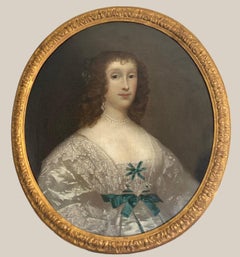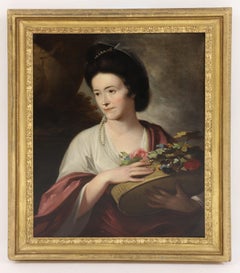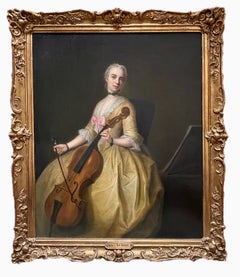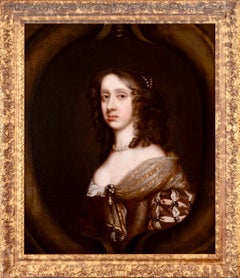Want more images or videos?
Request additional images or videos from the seller
1 of 20
Circle of Marcus Gheeraerts the YoungerPair of early 17th century Jacobean Portraits of William and Jane de Malbone1621
1621
$19,300.56List Price
About the Item
- Creator:Circle of Marcus Gheeraerts the Younger
- Creation Year:1621
- Dimensions:Height: 34.45 in (87.5 cm)Width: 28.15 in (71.5 cm)
- Medium:
- Movement & Style:
- Period:Early 17th Century
- Condition:
- Gallery Location:Bath, GB
- Reference Number:1stDibs: LU9526882322
About the Seller
5.0
Vetted Professional Seller
Every seller passes strict standards for authenticity and reliability
Established in 2002
1stDibs seller since 2015
37 sales on 1stDibs
Associations
The British Antique Dealers' AssociationLAPADA - The Association of Arts & Antiques DealersInternational Confederation of Art and Antique Dealers' Associations
Authenticity Guarantee
In the unlikely event there’s an issue with an item’s authenticity, contact us within 1 year for a full refund. DetailsMoney-Back Guarantee
If your item is not as described, is damaged in transit, or does not arrive, contact us within 7 days for a full refund. Details24-Hour Cancellation
You have a 24-hour grace period in which to reconsider your purchase, with no questions asked.Vetted Professional Sellers
Our world-class sellers must adhere to strict standards for service and quality, maintaining the integrity of our listings.Price-Match Guarantee
If you find that a seller listed the same item for a lower price elsewhere, we’ll match it.Trusted Global Delivery
Our best-in-class carrier network provides specialized shipping options worldwide, including custom delivery.You May Also Like
Tri-Directional Portrait Commemorating the Russo-Turkish War
Located in New Orleans, LA
Austrian School
18th Century
Tri-Directional Portrait Commemorating the Russo-Turkish War
Oil on wooden strips
This extraordinary tri-directional portrait exemplifies the rare innovation known as a triscenorama, capturing a pivotal diplomatic moment through ingenious artistic technique. Employing triangularly cut wooden strips, this remarkable work simultaneously depicts three imperial figures central to the Russo-Turkish War of 1735-1739: Empress Anna Ivanovna Romanova of Russia when viewed directly, Holy Roman Emperor Charles VI from the left and Ottoman Sultan Mahmud I from the right, commemorating the Treaty of Nissa that concluded this significant European conflict.
The portrait utilizes an exceptionally rare optical technique that predates modern movable imaging technology. When observed from different angles, the painted triangular wooden strips create a transformative effect, revealing entirely different imperial portraits as the viewer shifts position. The precision required to execute such a work demonstrates remarkable technical mastery, as the artist had to conceptualize three distinct portraits as well as the meticulous arrangement of the panels. This sophisticated manipulation of perspective creates an interactive viewing experience considered revolutionary for its time.
Almost certainly created by an Austrian artist, this diplomatic artwork likely served as a commemorative piece marking the Treaty of Nissa, signed in September 1739. The treaty concluded Russia's ambitious campaign to secure access to the Black Sea while countering Ottoman raids in Ukraine and the Caucasus regions. Given its exceptional quality and historical significance, this portrait was possibly commissioned by Emperor Charles VI himself, potentially serving as a diplomatic gift to either Empress Anna or Sultan Mahmud I during the treaty negotiations.
Under Empress Anna's leadership, Russia sought to counter devastating raids from Ottoman allies, particularly the Crimean Tatars...
Category
18th Century Old Masters Portrait Paintings
Materials
Wood, Oil, Wood Panel
$148,500
H 18.88 in W 15.88 in D 2 in
Angelic Cherubs with Classical Figure in Wilderness Finely Painted Preparatory
Located in Cirencester, Gloucestershire
Figure with Cherubim in Wilderness
Italian School, 17th century
oil painting on wood panel
framed 13 x 11 inches
condition: overall for its age very good, though the work is most likely a preparatory...
Category
17th Century Old Masters Figurative Paintings
Materials
Oil, Wood Panel
$3,584
H 13 in W 11 in D 1 in
Large 17th Century Dutch Old Master Oil Painting on Wood Panel Biblical Scene
Located in Cirencester, Gloucestershire
Biblical Figures, Large Gathering around Christ?
Dutch Old Master, early 17th century
oil painting on wood panel, stuck on velvet backing board
velvet board: 27 x 29 inches
board: 25.5 x 26 inches
provenance: private collection, France
condition: good and sound condition, obvious old panel...
Category
Early 17th Century Old Masters Figurative Paintings
Materials
Oil, Wood Panel
Portrait of a Gentleman, Doublet & White Ruff, Gloves Inscribed 1624, on panel
By Frans Pourbus the Younger
Located in London, GB
Titan Fine Art presents this exquisite oil on panel portrait depicting a handsome young gentleman in an exuberant black damask doublet. The pose, with one hand holding gloves and the other akimbo, was one that was well-established for gentleman of the upper echelons of society by the time this work was painted. The principle governing portraits at this time was the recording and defining in visual terms of the position of a sitter in society. In addition to brilliant and complex symbols of luxury, they often contained many symbolic elements too; the inclusion of gloves was often used in portraits that celebrated a betrothal as in ancient times gloves were used to seal a marriage contract.
The extraordinary costume of a black shimmering doublet, the brilliant white reticella ruff, and the cuffs edged with lace were immensely costly… this attire proclaims to every onlooker that this is a superior being. The rendering of the reticella lace ruff is exquisite and the artist has recorded the design that runs through the black damask fabric with meticulous attention to detail. The preservation of this black pigment is remarkable considering the age of the work. Black pigments are especially vulnerable to fade and wear over time partly due to environmental condition but also from unprofessional cleaning. This work is an exquisite example from the period.
According to the inscription in the upper right, the gentleman was in his 22nd year of age in 1624. The coat of arms, which is displayed without a crest, may be ‘blazoned’ in the language of heraldry, as: Sable on a Chevron between in chief two Roundels and in base a Billet [or possibly Square] Or three Martlets Sable. In plainer English this means a black (Sable) background, spanned by a gold (Or) chevron, above which are two golden solid circles (Roundels), and below which is a gold rectangle (Billet); on the chevron are three small black birds (Martlets). Martlets are a stylised form of heraldic bird, believed to be based on the swift, which are conventionally drawn with small tufts instead of feet. In Continental Europe it is also conventional for them to be drawn without beaks, as appears to be the case here. The birds in this instance also have a vaguely duck-like appearance.
Five families have been identified with very close armorial bearings to the one in our portrait. They are the (van) Houthem’s (of Brabant), the Prévinaire’s (of Flanders and Holland), and the Proveneer’s (of Liège) and it must be noted that the locations of these families also fit with the painting’s Flemish origins. However the French Grenières’s (of Île-de-France) and the Jallot’s (of Normandy) are the next closest matches and plausible matches, as Frans Pourbus had settled in Paris just a few years before our portrait was painted.
This painting has been assessed by a professional conservator prior to going on sale, and as thus, it can be hung and enjoyed immediately.
Frans Pourbus the Younger...
Category
17th Century Old Masters Portrait Paintings
Materials
Oil, Wood Panel
$18,404
H 42.13 in W 31.11 in D 3.94 in
Lucretia, by Giacomo Raibolini Francia. Detto il Francia. Oil on panel, framed
Located in New York, NY
Giacomo used to paint with his brother Giulio, identifying their works with the monogram «I I». The strong influence of his father, Francesco, is undeniable in all his works, althoug...
Category
16th Century Old Masters Figurative Paintings
Materials
Oil, Wood Panel
$18,000
Free Shipping
H 25.6 in W 19.3 in D 1.19 in
Christ on the Cold Stone – After Jan Gossaert (Mabuse)
Located in Stockholm, SE
This striking devotional image, painted by a follower of Jan Gossaert, represents one of the most influential compositions of the Northern Renaissance: Christ on the Cold Stone, or C...
Category
16th Century Old Masters Figurative Paintings
Materials
Oil, Wood Panel
Portrait of an Elderly Man
Located in Stockholm, SE
This finely executed oil painting, attributed to the circle of Christian Wilhelm Ernst Dietrich, captures the contemplative expression of an elderly man, his gaze lowered in quiet re...
Category
Early 19th Century Old Masters Portrait Paintings
Materials
Oil, Wood Panel
Portrait of an Old Bearded Man
Located in Stockholm, SE
We are pleased to offer a captivating portrait, most likely painted in the late 18th century, attributed to an artist within the circle of Christian Wilhelm Ernst Dietrich. This oil ...
Category
Late 18th Century Old Masters Portrait Paintings
Materials
Oil, Wood Panel
17th Century Portrait of Reverend and Reformer John Calvin
Located in Stockholm, SE
A Rare 17th-Century Portrait of John Calvin
This small interesting portrait, of John Calvin (1509–1564) offers a rare glimpse into the enduring legacy of the French-Swiss reformer. P...
Category
17th Century Old Masters Portrait Paintings
Materials
Oil, Wood Panel
$2,528
Free Shipping
H 10.16 in W 9.06 in D 1.19 in
Early 17th Century by Tiberio Titi Portrait of a Gentleman Oil on panel
Located in Milano, Lombardia
Tiberio Titi (Florence, Italy, 1573 – 1638)
Title: Portrait of a Gentleman
Medium: Oil on panel
Dimensions: Without frame 122 x 91 cm – with frame 162 x 133 x 10 cm
Publications: G...
Category
Early 17th Century Old Masters Portrait Paintings
Materials
Oil, Wood Panel
$107,052
H 48.04 in W 35.83 in
More From This Seller
View All17th century portrait of lady in an ivory silk gown and lace collar
By Cornelius Johnson
Located in Bath, Somerset
Circle of Cornelius Johnson (1593-1661), a 17th century portrait of a lady, bust-length oval, wearing an ivory silk gown with blue silk bows and lace c...
Category
Early 17th Century Old Masters Portrait Paintings
Materials
Canvas, Oil
$16,543 Sale Price
25% Off
18th century English portrait of a lady beside an urn, with a basket of flowers
By Tilly Kettle
Located in Bath, Somerset
Portrait of a lady wearing a white gown with a red cloak, pearls in her hair and draped over one shoullder, standing beside a classical urn with a basket of flowers, c.1765.
The portrait is believed to be a companion portrait of a John (1741-1816) or James (1751-1807) Durno which is housed in an identical frame. The sitter is possibly either the wife of John who was Janes Byres of Stonywood or John and James's sister Elizabeth. (James never married). The Durno family were based around the Aberdeen area of Scotland and John was an advocate in the area and then later a customs official in Jamaica. James was a successful timber merchant, spending time in the Baltic before being made His Majesty's Consul in Memel, Prussia.
The portrait is likely to have been painted before Tilly travelled to India in 1768, when John, Jane and Elizabeth would have been in their twenties.
We are gtrateful to Mark Beattie for sharing his family knowlege and research on the portrait.
Provenance:
With W. C. Beattie in the mid 19th century, and by descent through the family
Private collection, Kent
With thanks to Hugh Belsey who has confirmed this to be the work of Tilly Kettle from photographs.
Tilly Kettle (1735-1786) was born in London, the third of six children by Henry Kettle (c.1704-c.1773), a coach painter, and his wife Ann. He attended William Shipley...
Category
18th Century Old Masters Portrait Paintings
Materials
Canvas, Oil
18th century portrait of the artist’s daughter, Catharina, playing the cello
By Balthasar Denner
Located in Bath, Somerset
The sitter, seated in a yellow silk gown trimmed with a pink bow playing the cello, is believed to be the artist Balthazar Denner's eldest daughter Catharina (1715-1744), after his marriage to Esther Winter in Hamburg in 1712. She is also recognisable in another portrait of the Denner family in the Hamburg Kunsthalle, painted circa 1740 by the artist's son, Jacob Denner (1722-1765). Oil on canvas in a period giltwood frame.
Provenance: Private collection, Northern Germany
Professor Helmut Borsch-Supan, Berlin, confirmed the authenticity of the painting after examining it in 2013. The painting will also be included in the forthcoming catalogue raisonnée of the artist, by Ute Mannhardt.
Balthasar Denner...
Category
Early 18th Century Old Masters Portrait Paintings
Materials
Canvas, Oil
17th century English portrait of a lady
By Willem Wissing
Located in Bath, Somerset
Portrait of a lady attributed to William Wissing, half-length, wearing a pearl necklace and an amber gown adorned with jewels to the bodice and sleeves, wit...
Category
17th Century Old Masters Portrait Paintings
Materials
Canvas, Oil
English 18th century portrait of a Lady and her Daughter in an interior
By (attributed to) Joseph Highmore
Located in Bath, Somerset
Portrait of a lady, three-quarter length, wearing a blue silk gown, seated in a classical interior, with her daughter in a pink gown standing beside her holding a sprig of blossom. T...
Category
Early 18th Century Old Masters Portrait Paintings
Materials
Oil
A pair of Dutch 17th century old master portraits of a husband and wife
By Nicolaes Maes
Located in Bath, Somerset
A rare pair of three-quarter length 'marriage' portraits by one of the foremost dutch portrait painters of the 17th century, Nicolaes Maes (Dordrecht 1634-1693 Amsterdam). The gentleman signed middle left 'Maes 1679'. Oil on canvas in dutch style ebonised frames. Dimensions 58 x 47.5cms each.
The gentleman is shown in a landscape at dusk, leaning against a stone capital, wearing a white chemise decorated with lace, a black coat and a brown silk cloak draped across his body.
The lady is elegantly dressed in an ivory silk gown decorated with jewels on the neckline and shoulders, the contrasting sleeves in gold fabric, with a rose pink silk cloak draped over her shoulder and bodice. She wears a pearl necklace and earrings with her fair hair worn up with ringlets falling down onto her chest in the fashionable style of the day. She stands with one hand touching a lock of her hair as she rests her arm on the bowl of a stone water drinking fountain...
Category
17th Century Old Masters Portrait Paintings
Materials
Canvas, Oil
Recently Viewed
View AllMore Ways To Browse
James Denmark
Gold Portrait Miniature
Funeral Procession
17th Century Oak Panels
Lord Of The Rings Paintings
Gold And Coral Chain
Jacobean Era
Matador Costume
Mr And Mrs Howard
Oil On Tin Portraits
Oil Painting Portait
Painting Babushka
Peter Max Asia
Portuguese Painting Old
Princess Diana Signed
Puritan Oil Painting
Puyet Jose
Raimundo De Madrazo Y Garreta



